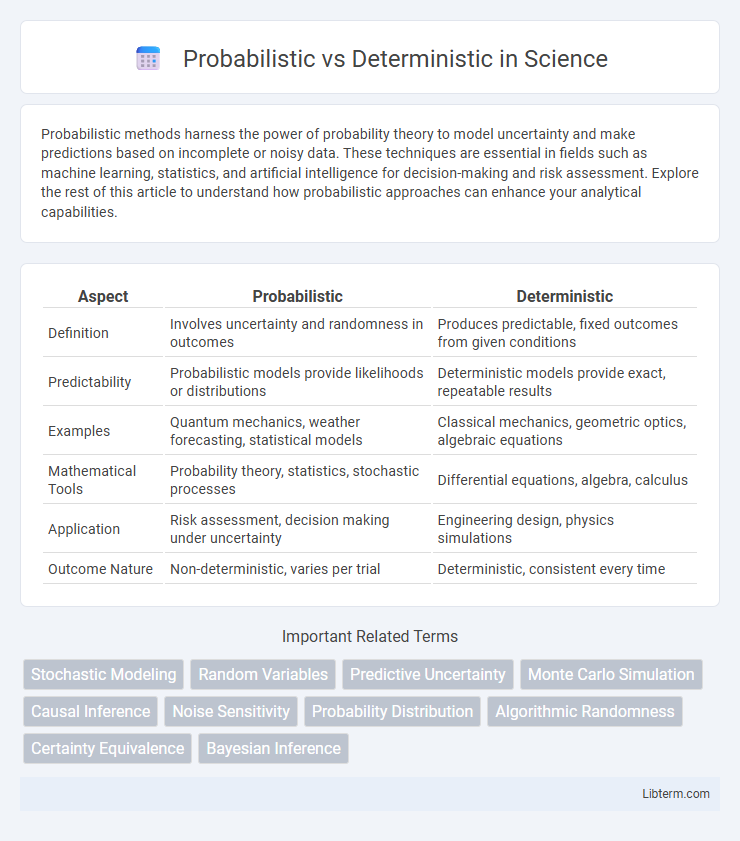Probabilistic methods harness the power of probability theory to model uncertainty and make predictions based on incomplete or noisy data. These techniques are essential in fields such as machine learning, statistics, and artificial intelligence for decision-making and risk assessment. Explore the rest of this article to understand how probabilistic approaches can enhance your analytical capabilities.
Table of Comparison
| Aspect | Probabilistic | Deterministic |
|---|---|---|
| Definition | Involves uncertainty and randomness in outcomes | Produces predictable, fixed outcomes from given conditions |
| Predictability | Probabilistic models provide likelihoods or distributions | Deterministic models provide exact, repeatable results |
| Examples | Quantum mechanics, weather forecasting, statistical models | Classical mechanics, geometric optics, algebraic equations |
| Mathematical Tools | Probability theory, statistics, stochastic processes | Differential equations, algebra, calculus |
| Application | Risk assessment, decision making under uncertainty | Engineering design, physics simulations |
| Outcome Nature | Non-deterministic, varies per trial | Deterministic, consistent every time |
Introduction to Probabilistic and Deterministic Approaches
Probabilistic approaches model uncertainty by assigning likelihoods to different outcomes, enabling prediction through statistical inference and data variability. Deterministic methods provide precise, fixed outcomes based on predefined rules or equations without accounting for randomness or variability. Understanding the contrast between probabilistic and deterministic models is essential for selecting appropriate techniques in fields such as machine learning, risk assessment, and systems engineering.
Defining Probabilistic Models
Probabilistic models represent uncertainty by assigning likelihoods to different outcomes based on statistical distributions, capturing the inherent randomness in data and processes. These models quantify the probability of events using methods such as Bayesian networks, Markov chains, or Gaussian processes, enabling predictions even with incomplete or noisy information. Unlike deterministic models that produce a fixed output from given inputs, probabilistic models express a range of possible results, reflecting real-world variability and complexity.
Understanding Deterministic Models
Deterministic models operate under the premise that given a specific set of inputs, the output will always be the same, providing predictability and consistency in results. These models use fixed parameters and equations to describe systems, making them ideal for scenarios where uncertainty is minimal or negligible. Understanding deterministic models is crucial in fields such as physics, engineering, and economics, where precise forecasting and replication of outcomes are essential.
Key Differences Between Probabilistic and Deterministic Methods
Probabilistic methods incorporate randomness and uncertainty, providing outcomes as probability distributions or likelihoods, while deterministic methods produce fixed, predictable results given the same initial conditions. Probabilistic models are essential in scenarios with incomplete information or inherent variability, employing techniques like Monte Carlo simulations and Bayesian inference. Deterministic approaches are preferred in systems with well-defined parameters and predictable behavior, such as classical physics models and algorithmic computations.
Common Applications of Probabilistic Systems
Probabilistic systems are widely used in fields like machine learning, natural language processing, and robotics where uncertainty and variability are inherent. Applications such as spam filtering, speech recognition, and predictive analytics leverage probabilistic models like Bayesian networks and Markov chains to make informed decisions based on incomplete or noisy data. These systems outperform deterministic models in environments requiring adaptability and handling of stochastic processes.
Real-World Use Cases for Deterministic Systems
Deterministic systems are widely used in real-world applications where predictable and repeatable outcomes are critical, such as in industrial automation, aerospace control systems, and financial transaction processing. These systems rely on precise algorithms and set rules to ensure consistent performance, reducing uncertainty and enhancing reliability in operations like robotic assembly lines and avionics navigation. Their capacity for exact calculations and error minimization makes them indispensable in environments demanding high safety and accuracy standards.
Advantages and Limitations of Probabilistic Approaches
Probabilistic approaches excel in handling uncertainty and modeling complex, real-world phenomena with inherent randomness, making them ideal for applications like weather forecasting, speech recognition, and financial modeling. These methods provide flexible frameworks that incorporate prior knowledge and update beliefs as new data emerges, enhancing prediction accuracy in dynamic environments. However, probabilistic models often require substantial computational resources and large datasets for reliable inference, and their interpretability can be limited compared to deterministic counterparts, which offer straightforward, rule-based predictions.
Pros and Cons of Deterministic Methods
Deterministic methods offer clear advantages such as reproducibility and predictability, providing consistent outcomes given the same initial conditions. Their main drawback lies in inflexibility and inability to handle uncertainty or variability, which limits performance in complex or dynamic environments. These methods are best suited for well-defined problems with stable inputs but may underperform compared to probabilistic approaches in real-world applications involving randomness or incomplete data.
Choosing Between Probabilistic and Deterministic Strategies
Choosing between probabilistic and deterministic strategies depends on the nature of the problem and available data. Probabilistic methods suit environments with uncertainty and incomplete information, leveraging statistical models to predict outcomes. Deterministic approaches work best when variables are known and fixed, providing precise and reproducible results essential for optimization and control systems.
Future Trends in Probabilistic versus Deterministic Modeling
Future trends in probabilistic versus deterministic modeling emphasize the integration of machine learning and artificial intelligence to enhance uncertainty quantification and predictive accuracy. Probabilistic models are expected to dominate in complex system simulations, leveraging big data and advanced algorithms for dynamic risk assessment. Deterministic modeling will continue to be valuable in scenarios requiring precise, reproducible outcomes, but hybrid approaches combining both paradigms are gaining momentum for improved decision-making under uncertainty.
Probabilistic Infographic

 libterm.com
libterm.com